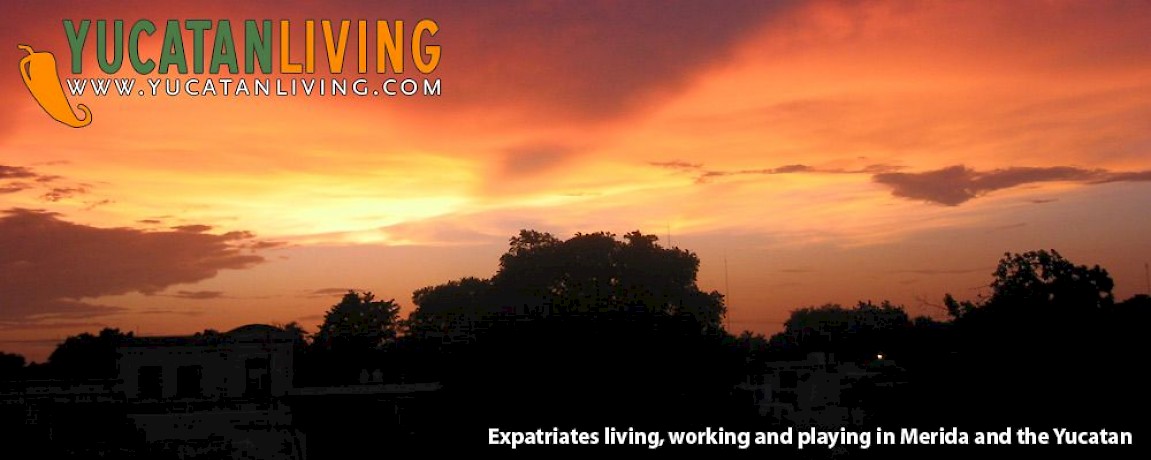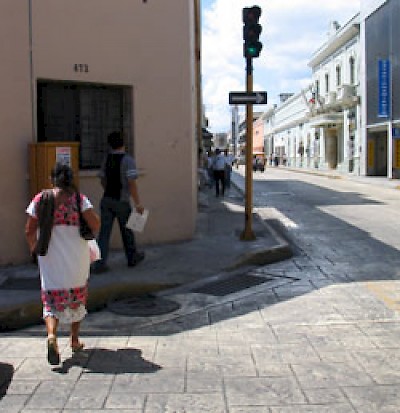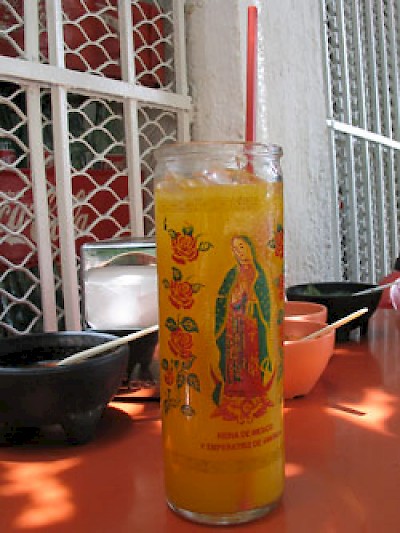Hay Calor!
For the past few days, the temperature here in Merida has soared and we are suddenly drinking a lot more water and Gatorade. It seems like only last week when it was a comfortable 80 degrees. Well, it really *was* only last week. The seasons turn quickly here, and this sudden change of weather tells us we're about to pay for our paradise with a little hay calor! (it’s hot!) Or if you prefer the Mayan: choco kin!
It doesn't confuse us anymore that in Mexico, as in most of the world, they report the temperature in Centigrade, which means it’s "only" 40 degrees right now. We now know that 40 degrees means a walk outside puts us in danger of heat exhaustion, but for the sake of our US audience we'll speak in Fahrenheit for the remainder of this article.
The Yucatan has four seasons, just like everyone else, but they are not very different. In fact, they are variations on only two themes: temperature and humidity.
Spring: hot and dry
Summer: hot and wet
Fall: cool and wet
Winter: cool and dry
Of course, the word “cool” is relative. We'll define cool to mean that the day's high temperature is below 90 degrees. We've seen a few days in January when the temperature dipped into the 50's at night and never rose above 70 during the day. There are several weeks during the winter months when you'll want a light coat or sweater. But in general, the cool days are still tropical, so shorts and a t-shirt in public and a sarong at home work for us.
Hot is also a relative term. The highest average temperature in Merida - usually recorded in May - is 97 degrees and it seldom goes higher than 105. Sounds hot enough, right? Well, there are places where we come from where the temperature can exceed a scorching 120 degrees. On paper, that makes Merida look a bit less punishing, but as anyone from the southwestern part of the United States will remind you: “…it’s dry heat.” Here in Yucatan, we have a different reminder: “it’s not the heat, it's the humidity.”
We're really tickled by the temperature report on weather.com when it says something like:
Merida
Temperature: 89
Feels Like: 104
What it should say is, “Feels Like: You're a Poached Egg”.
Humidity - Mother Nature’s warm, wet embrace – traps the heat in your body and raises your “core temperature”, which makes staying cool the first priority of living in the Yucatan.
Almost every aspect of Yucatan life - cultural, social and even architectural - is informed and influenced by the tropical climate. The traditional Mayan dress code is light, white cotton fabric, with panama style hats for men and a rebozo, or shawl, for the women. Surprisingly, you’ll seldom see locals wearing shorts or going shirtless; they prefer to keep their bodies covered. The main reason for this, we’ve observed, is to prevent a cool breeze, called a fresca, from sending a chill over clammy skin. This effect can cause muscle cramps and many believe it causes illness as well. When you are in a crowd in the Yucatan during the heat, you'll notice the distinct odor of baby powder. In this heat, baby powder is for everyone because it really does reduce the stickiness caused by such intense humid heat.
The Spanish tradition of siesta is popular in many parts of Mexico, and certainly here in Yucatan. The hottest part of the day is generally between the hours of 2:00 and 4:00 pm when it makes a lot of sense to stay indoors and rest, rather than court heat exhaustion. Most Yucatecos start their day rather early, often before sunrise, so they can eat breakfast and do their morning chores in the cool, early hours. The business day starts at 8:30 am and winds down by 2:00 pm. After lunch and a siesta, business picks back up and the formal day ends around sunset. The traditional dinner hour begins at 10:00 pm, and if you’re a real local, you may be chatting with friends or dancing salsa until 1:00 am or later. This lifestyle offers two days in one, with the majority of your social life spent during the coolest parts of the day. You don’t have to live here long to assimilate. In fact, it's harder not to.
One of the many charming features of Yucatan social life can be seen everywhere, from the smallest pueblos to the urban center of Merida, the largest city. After dark, entire families will tote any form of seating that may be handy outside their front doors so they can share the events of their day in cool, evening frescas. Passersby are obliged to walk through these impromptu living rooms, offering a polite “buenas noches” to the adults, an admiring smile for the children and a pat for the dog.
Tall and often ornate Spanish colonial facades line the streets of the historical centers of Yucatan's cities such as Merida, Izamal and Valladolid. This creates a somewhat canyon-like feel when walking between them, but can also offer an opportunity to beat the heat. With the exception of high noon, one side of the street is in shade and the other in sunlight. We call these the Yucateco side and the Gringo side, respectively. Locals instinctively choose the cooler but more crowded shady side, while tourists choose the less populated sun-drenched side and arrive at their destination sunburned and dehydrated.
One of the first Spanish words we learned after moving here was “tranquilo”, which has many uses, but generally means “relax, take it easy”. There’s a lot of wisdom in this word (in many different contexts) but the most noticeable one is that Yucatecos move slowly. There is no "hustle" in Yucatan. If you stride rapidly down the street as if you are in New York, your “core temperature” rises and you blithely melt into the pavement.
The architecture of Yucatan’s colonial homes is well adapted to the climate. Behind those tall facades are equally tall ceilings, often 18 to 25 feet above the tiled floors. As the heat of the day rises, it collects near the ceiling, while the tiles maintain a cooler atmosphere below. Add ceiling fans for circulation, thick limestone walls and a central patio for drawing fresh air into the surrounding rooms. The result is an ambiance somewhat like a wine cellar.
Despite their resemblance to mansions found in Europe and other colonial parts of Latin America, there is one thing you’ll never see in a colonial home in Merida: a fireplace.
But you will find something you’ll seldom see elsewhere: the hammock. This bit of Yucatan “furniture” is more popular here than sleeping on a mattress or sitting in an upholstered chair. Besides taking up less space (they can be easily stowed during the day), hammocks ventilate the entire body. On warm, sultry nights, sleeping in a hammock under a ceiling fan is a more pleasant experience than tossing and turning on a humid mattress. And nothing beats a hammock for a mid-day siesta.
Of course, the same modern technology that made such exotic destinations as Las Vegas and Miami safe for habitation is widely used here, namely air conditioning. These systems are usually “split” units, with the condenser located on the roof and the ventilator hung high on an interior wall. Most colonial homes are too large to fully air condition in this way, so you usually find them only in bedrooms. During summer, the operating costs of keeping cool at home can exceed $200 per month in electric bills.
Since many of the locals can’t afford to air condition their homes, they seek it out in other venues. On a particularly hot day, you’ll find that the large grocery chains, the shopping malls and especially the cineplex are packed with crowds who are there for the same reason others go to the beach.
Another option is to visit a local cenote, which is an opening in the limestone that exposes the aquifer underneath. The Yucatan Peninsula is dotted with hundreds of them. Some are on the surface, some in grottos and others hidden in caves. The water is cool, clear and usually around 72 degrees, which makes for a very refreshing swim.
There is a tradition in Merida that probably dates back to the ancient Maya. Every July and August, everyone takes off for the coast. Most go north to the Gulf of Mexico where a reliable trade wind blows from offshore, the same one that brought the Spanish conquerors from Europe. People rent the beach houses that North American “snowbirds” use during winter. Family and friends are invited. Spontaneous nighttime fiestas are celebrated on the streets and malecon, with seafood, music and plenty of cold cerveza.
A tropical environment like the Yucatan is for people who enjoy activities for cooling off. If you prefer to cuddle by the fireplace with the hush of snowfall outside your window… well, you might want to look elsewhere. On the other hand, if you like a dip in the pool and a cold drink while perfecting your tan, then you’re in the right place.
One last important linguistic note: there are (at least) three words in Spanish for “hot”. They are picante, caliente and calor. Gringos tend to confuse these. Picante, which comes from the verb picar (to sting) refers to anything spicy. Chiles and salsa are picante. Caliente generally involves fire. When you heat water it is caliente. Caliente also has the same sexual connotations as “hot” in English. A hotdog, literally translated, means a dog that is in heat. Calor refers to the weather.
These distinctions get blurred a bit. If it’s hot outside (calor) and it makes you feel hot, then when referring to yourself, use caliente, because you have been heated. The real trouble occurs with the difference between the English and Spanish use of “be” and “have”. If you say “estoy caliente” (I am hot), then you are confessing to being sexually aroused. You must instead say “tengo caliente” (I have hot). Although body language often helps clear up any misunderstandings, in neither case does it help to pant with your tongue hanging out.
Although it's unlikely you'd ever need to here, never use the expression, “estoy frio” (literally, I am cold). This means you are dead.











Comments
CasiYucateco 16 years ago
James, Having a "mini-split" air conditioner installed is a routine affair. Depending on the size of the bedroom, you can get a 110 v or 220 v model. They come in various cooling capacities. The stores selling the units are always familiar with installers or do it themselves for you.
A rough estimate is $1000 to $1500 US installed. There are much cheaper units and cheaper installations. Without knowing the specifics of the house, it is impossible to second-guess. If you can get by with a 110 v and the electrical system in the house is up to it, then that would be the cheapest. But if you need a 220 v unit and you have to have electrical upgrades all the way from front to back of the house, you'd be in the higher price range.
Some say older homes seem cooler because of the higher ceilings. But a friend insists comfort is simply a matter of shade and circulation. It is a matter of personal sensitivities, I guess.
Generally speaking, the more pavement and construction, the hotter it is. So Centro may be warmer than an neighborhood with lots of trees. And downtown Merida is factually about 10 degrees (F) warmer than a house in the country, day or night.
Anyway, the heat really isn't the problem for sleeping (say many/most), it is the humidity. If you buy a large AC unit, it will cool a room quickly, but leave the moisture. If you buy a smaller AC unit, it will cool the room more slowly, while removing more of the moisture. That's what you want. Look for advice from a reliable store, plus recommendations from friends and neighbors.
(Personally, I feel window units are the worst: noisy, inefficient, dusty, etc. Because they are installed in a hole in the wall, there is constant exposure to outside humidity through the unit itself. They are by far the cheapest initial outlay, however.)
Reply
james curet 16 years ago
How much of a problem and expense is airconditioning a bedroom in an older neighborhood? are the older homes (el centro) cooler than others?
Reply
Raquel Fischer 16 years ago
Can anybody please tell me about La Paz area as far as the weather, size of the city and if has the same infrastructure that has in Merida?
Thanks.
Raquel.
Reply
Jeff 16 years ago
You are all lucky! I am a teacher and lived/vacationed in Merida up to about 20 years ago. I can now retire and want to move back to Merida but I'm stuck with trying to sell two houses before we can make the move. With this economy, who knows when that will be. Hey Question! Are the prices of houses on the internet accurate or inflated?
Freezing in Michigan!
Jeff
Reply
Suzette 17 years ago
My Spanish teacher is from Merida (she used to teach english at a school there). Thetext that we use was written by a Spanish Professor from the university here and she is originally from Chile. They both say that the rule of thumb is that you use hay for weather that you can see ie. hay sol o hay nubes y hace for weather conditions that we feel ie. hace calor o hace frio. I owe my love of Progreso y Merida to my teacher and I was lucky to have been able to spend dos semanas at her Tia's beach house last year. I totally can't understand how she ever left there (even if it was for love) pero I am grateful that I met her or I probably would nunca have discovered the beauty of the Yucatan.
Reply
The Dark Side of Yucatan 18 years ago
[...] We have written about many of the challenges of living in Yucatan, including the heat and humidity, Moctezuma’s Revenge, insects, the language barrier and city traffic, but we try to approach these subjects in a way that is useful to potential expatriates, not as reporters trying to sell papers. [...]
Reply
Working Gringos 19 years ago
Gracias, vecinos! Everything you say is true... IF you're speaking Spanish. However, here in Merida, many native locals speak a combination of Spanish and Mayan, peppered with other influences, that we call Yucateco, so if it's hot outside, and you want to express yourself in Yucateco, it's "Hay Calor!" For more on Yucateco see the bottom of our article, Buenisimo and the Mayan Xic website.
Reply
Merida local 19 years ago
Saludos a todos!
While I realize that translating terms can be confussing for Gringos, it's not too hard. We say "tengo calor" for us and "esta haciendo calor" for the weather, you can use "hace calor" too. If you want to use the "esta poniendo caluroso" be sure to add the "se" at the beginning other wise it sounds funny, if you're referring to the climate.
We lived in Las Vegas (dry heat) and Puerto Vallarta (humid heat) for many years and we can say that Merida is not as hot as Vallarta, especially in the summer, so it's been an easy change for us and we really appreciate the cooler evenings, they are wonderful! We greatly missed all the traditions you speak off while in the US and we are happy to have returned to Mexico.
Happy Mes de la Patria!
Reply
Sherry 19 years ago
Thanks!
I will be in Merida this weekend!
Reply
Working Gringos 19 years ago
Thanks, Sherry. We hope you enjoy your travels. (We completely understand about the kids.) When we first started using a blog platform, we used Blogger (and we're professionals), but like they say, it's the shoemaker's kids who have no shoes. We eventually found the time to upgrade, but if you're just getting started, you can't beat free and easy: http://www.blogger.com
Reply
Sherry 19 years ago
Muchas gracias, Gringos, for your list of suggestions of must-see/do!! I cannot wait -- I do my own little happy dance at least twice a day just thinking about my upcoming trip to Merida. (My kids think I'm nuts.)
I will definitely keep in touch.
Speaking of which...I've never done it before, but I'm considering creating a blog (complete with photos) specifically to share my trip with close friends and relatives. Can you suggest a blog host that is user-friendly for a blogger novice?
Thanks!
Reply
« Back (10 to 21 comments)Next »